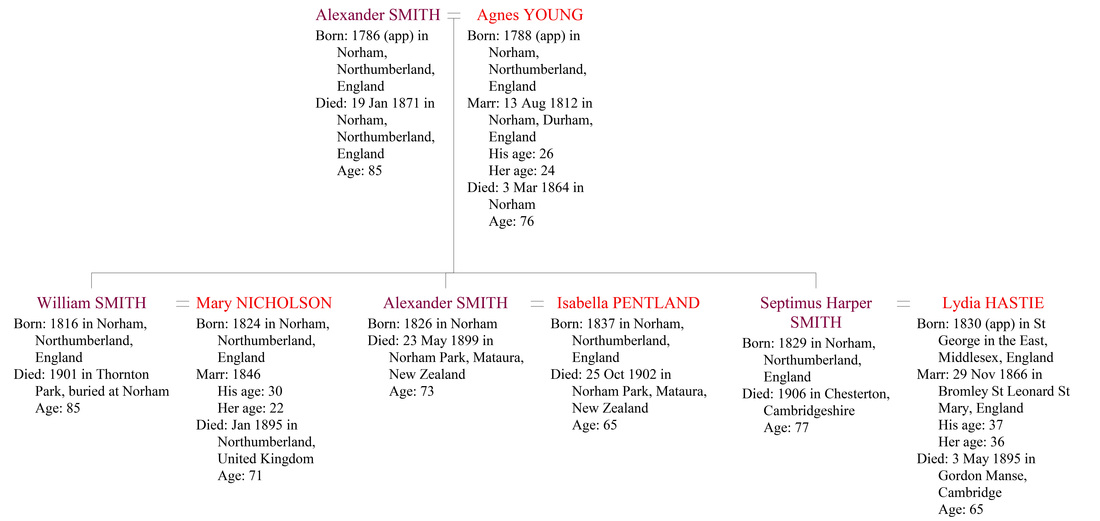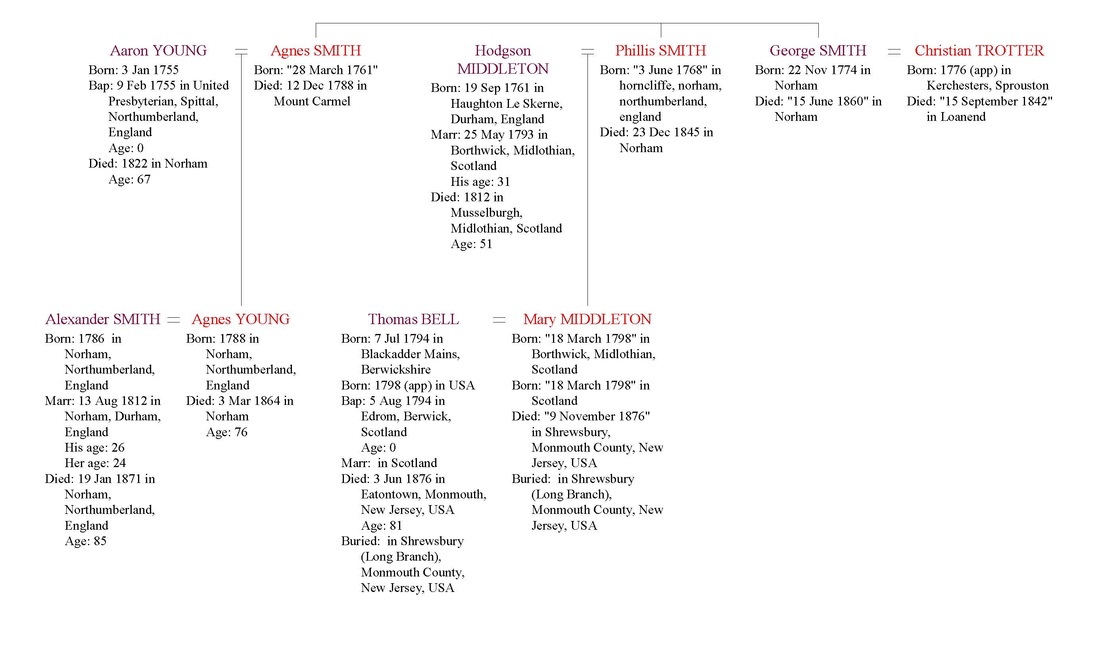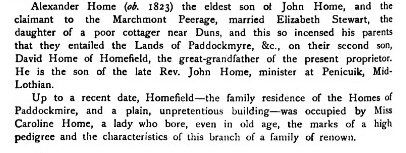IntroductionI can’t believe that another month has passed and it is approaching blog time again. As August is going to see the Harper-Smith family visiting their ancestral ‘homeland’ of North Northumberland and the Scottish Borders, I have been digging around for some new information and putting together an interactive map of places they may like to visit. What came to light in the course of the research confirmed some long held suspicions and contains more twists, turns, entries and exits than spaghetti junction. I shall however, try my best to keep the explanations as simple as possible. Hasties & SmithsFirstly I should explain that the Harper-Smiths are fourth cousins to myself, being descended from Agnes Smith 1761-1788 the first wife of Aaron Young.* Aaron Young married for a second time in 1801, but we shall come to that presently. Poor Agnes died in childbirth, but their only child Ann (or Agnes) survived, and in August 1812 married Alexander Smith (1) (1786-1871) of Galagate Farm, Norham. Together Alexander and Ann had eight children and their youngest Septimus, born Norham in 1829, married at Bromley St Leonard, Middlesex in 1866 one Miss Lydia Hastie. Lydia had been born in Middlesex in 1830, so it begged the question as to how the young man from Northumberland and she had met. A look into Lydia’s parentage, and the marriages of her two siblings held the answer, and has potentially set in motion an entirely separate family history project surrounding this Hastie family. As you read on, if you believe you too maybe connected to this family, please do get in touch. Anyway, back to Lydia Hastie. She was the second of three children born to Robert Hastie (2) and his wife Lydia Vaux. Lydia’s father Robert had been born at Fowberry, near Chatton in 1794, his occupation was corn merchant, and her mother’s maiden name was Vaux. The marriages of Lydia’s two siblings Peter and Sarah to other ‘Haisties’ was quite intriguing. They, of course, proved to be cousins. Lydia’s sister Sarah married in Middlesex in 1858 her first cousin James Hastie, son of William Hastie and Jean Clarke born 1828 at Blackadder East Mains in Berwickshire. One of 10 children born to the William and Jean (7 survived into adulthood), James was also a corn merchant by profession. Together Sarah and James had six children, 3 boys and 3 girls and seem to have been quite close to their Harper-Smith cousins. Three members of the Harper-Smith's appear to be staying with the family in the 1891 census and repeatedly turn up as executors in respective wills. A lot more research is needed into this branch of the Hastie family. Lydia’s brother Peter, also married a first cousin, Grace Hastie born in Hutton in 1833 daughter of John Hastie and his wife Helen Bell (3). Peter was yet another corn merchant. The pair married at Hutton in 1859. However their marriage does not appear to have been a happy one at all and ended in an acrimonious divorce in 1871. Accounts of the divorce proceedings list a catalogue of domestic abuse rendering Grace unconscious and on one occasion broke one of her teeth. On the 22 March 1871 Grace testified he even threatened to murder her. Peter denied the charges stating in his defence that: The Petitioner is a woman of aggravating manner and that if on any occasion he has been guilty of violence towards her he has been provoked thereto by her violence and insulting and irritating language and conduct. Rather unpleasant all round. Their only daughter Helen Lydia Hastie born in 1864, never married and died in Florence, Italy in 1933. A twist in the tale here is that this Grace Hastie was also a blood relative of Alexander Smith of Galagate, Norham as she was the granddaughter of Alexander’s sister Grace Smith and her husband William Bell. There is a further twist in the familial relationships between Bell and Smith family which will appear a bit later. A picture is starting to emerge for the Hastie family as farmers, corn merchants and from further research also millers. Robert Hastie at (2) above was the youngest son of a veritable tribe of 9 children born to Peter Hastie and his wife Elizabeth Moffat. Peter’s original occupation was blacksmith before taking the tenancy of Broad Meadows farm near Hutton at some point after 1800. It is at this point that many Hastie researchers have hit their brick wall, but I do believe I may just have found the necessary sledgehammer to break it down. The name Peter is often interchangeable with Patrick, particularly among Scottish families in the 18th and 19th centuries, and I have encountered this phenomenon before. Sure enough, although there is no Peter in the baptism records there is a Patrick. The real breakthrough came in the form of two wills of Peter’s unmarried siblings. Robert in 1829 and Thomas in 1832. Both brothers were millers at Fenton Mill are packed with information about other family members as unmarried wills of relatives often are. At the time of Thomas’s death in 1832 Peter was farming at Broad Meadows, a brother John was a yeoman in Yetholm, another brother William had emigrated to Lower Canada and there were two married sisters. Their father, also Thomas was buried at Kirknewton in June 1808 aged 90, occupation Miller at Fenton. This new information has potentially taken the family back to 1718, and living in the area from the 1750’s as the children are all baptised in Wooler. As Presbyterians, the family may well have originated over the Border in Scotland, and it will be interesting to see if their origins can be traced. Hopefully this article will bring a few more Hasties out of the woodwork. Moving away from the Hasties and returning to Alexander Smith (1) of Galagate, father of Septimus and his father-in law Aaron Young. Whilst it is often stated in notes in our family archive that Alexander Smith was no relative of ‘our’ Smiths, (also of Norham), there has always been a niggling doubt as to the extent of the familial connection. George Smith of Loanend crops up just too many times as an executor. In search of some possible clues concerning Alexander I have re-read some of the early letters of Sarah Nicholson. In letter three of the 6th March 1910 she writes of him; Alexander Smith, Galagate was a sailor & fought, I believe in the Battle of the Nile, but I am not sure of which battle. Annie Smith [his granddaughter] has his sword in her hall at Berwick.’ I can find no evidence for Alexander’s participation in the Battle of the Nile, which took place from 1-3 August 1798. This I find unlikely as he would have only been 12 years old at the time. However, records contained in the Naval Archives indicate he may have been a 2nd Lieutenant in the Royal Marines aboard the British Flagship ‘HMS Superb’ at the Battle of St Domingo in 1806 at the age of 20. Further records indicate he may also have served on ‘HMS Donegal’ and as 1st Lieutenant Royal Marines aboard ‘HMS Venerable’. This would corroborate his entry in the 1851 census. But who were his parents? Again it was a will that led the way, a William Smith of Horncliffe who died in 1815, proved to be Alexander’s father. He was interred in Hutton, with several daughters and wife Jane in the adjacent plot to Grace Bell (nee Smith) another daughter and her husband William. I believe, based on one very ill written entry in the Ladykirk register that Jane’s maiden name was Fergy or Fargy. This too would make sense as it appears several times as a Christian name in later generations. She may have been the daughter of Thomas Fergie a portioner in Paxton, a parish adjacent to Hutton. However, this has yet to be verified. Grace Smith and William Bell had at least 5 children of which Helen Bell (3) above, (married John Hastie and was mother to Grace of the bitter divorce described earlier). Here comes the first twist…the eldest son of William and Grace Bell was called Thomas b. 1794 and married Mary Middleton circa 1818. Mary was the daughter of Phillis Smith and Hodgson Middleton of Arniston Mains, Borthwick in Scotland. Phillis Smith was sister to both Agnes Smith, 1st wife of Aaron Young and George Smith of Loanend. Descendants of Thomas Bell and Mary Middleton are genetically linked to both the Smith family of Galagate and 'our' Smith family of Norham. (See below) Thus Mary Middleton was 1st cousin to Ann wife of Alexander Smith. If you think that is confusing try the next twist. Alexander Smith was the youngest of 9 children born to William Smith and Jane Fergy. His elder sister Margaret became the 2nd wife of Aaron Young in 1801. As a result of this marriage Alexander Smith who was already Aaron Young’s son-in-law also became his brother in law! The witnesses to the marriage were William Bell (above) and David Home. The next twist in the tale concerns David Home himself, who is also mentioned in Sarah Nicholson’s letters. Thank you for letting me see the old letters from Mr David Hume [sic]. You will be surprised to hear I have a letter from one of his granddaughters – daughter of Helen Hume, which I enclose … It would appear that the lady in question was married and called Ferguson, maiden name Kitson (I think this should be Ritson). Alas none of these letters appear in the archives which I have here, but may well be elsewhere in the family’s collection. David Hume mentioned above was actually David Home of Homefield, Coldingham who married another of Alexander’s sisters Jean, in 1795 at Coldingham. It was whilst looking into this family that I stumbled across this little gem, written in July 1804, contained in an old brandy bottle and found in a wall in 1960. The house was built by John Home my father Anno 1759, and repaired by me Anno 1804, I have at the same time claimed the entailed estate of Marchmont before the Court of Session and have also compelled my elder brother [Alexander] to petition the House of Peers for the titles in spite of the threats and villainous machinations of the now notorious knave Hugh, Earl of Marchmont and Patrick Home of Billie son of Ninian Home, late school master of Fogo, who robbed my father of the old estate of Wedderburn and Billie. David Home of Homefield. on the reverse; May heaven protect the brave Clan Home and may they flourish with an Earl of Home as their head for a thousand years. Well, I am sure you can imagine my surprise. Alas, neither Alexander nor David were successful in regaining their titles, and from a book written by David’s nephew George (a midshipman on the Bellepheron) ‘Memoirs of an Aristocrat and Reminiscences of Napoleon’, the feud became a bitter one indeed. The events that led up to the alleged ‘theft’ are long, complicated and don’t form part of the story of the Smith and Hastie families, but is interesting none the less. As for other descendants of Alexander and his wife Ann Young, only the progeny of Septimus Harper-Smith remains in the UK today. Alexander junior married Isabella Pentland of Norham and emigrated to New Zealand where there is now a quite a clan, with whom I am in regular contact. Another son William married Mary Wood Nicholson and although they had a large family, few married or had children. The exception was their son Aaron Young Smith, a school teacher, who also emigrated to New Zealand. He married Ellen Maud Wilkins, the sister of his cousin William Young Smith’s wife and had issue, at least three daughters. We believe there may still be descendants of Aaron Young Smith living in South Island New Zealand. If you happen to be one of them, please do get in touch. The last living descendant of William Smith and Mary Wood Nicholson was Mary Wood Smith. Along with her spinster sister Agnes they lived at Rokeby, Castle Terrace, Berwick upon Tweed. Agnes died in 1932, and in her will she made special mention of brother, Arthur Alexander living in Australia, of whom very little is known. Mary herself died in September 1943, and I am hoping that her will may hold some clues as to the whereabouts of her grandfather Alexander’s sword. If no specific mention of it is made, the sword was perhaps entered in the house clearance sale which took place in Millers saleroom, Berwick in 1944. I always think it sad when personal items such as this are sold off, as in some ways they lose their significance to a family’s history. However, everyone’s circumstances are different and their decisions should be respected. It may have been Mary’s choice to sell and convert her assets to cash for the benefit of her legatees living overseas. After all, money is a lot easier to send to New Zealand than a sword. *Aaron Young drowned in the river Whiteadder on 31st December 1822. LinksGeorge Home Memoirs of an Aristocrat 1838 https://archive.org/details/memoirsanaristo01homegoog A Thomson FSA (Scot) Coldingham:Parish and Priory 1908
https://archive.org/stream/coldinghamparis00thomgoog#page/n12/mode/2up
8 Comments
|
AuthorSusie Douglas Archives
August 2022
Categories |
Copyright © 2013 Borders Ancestry
Borders Ancestry is registered with the Information Commissioner's Office No ZA226102 https://ico.org.uk. Read our Privacy Policy









